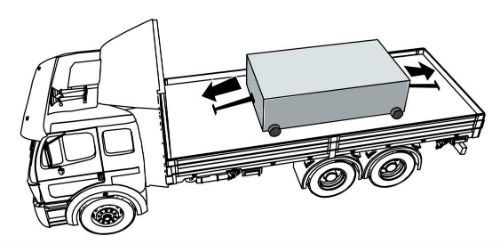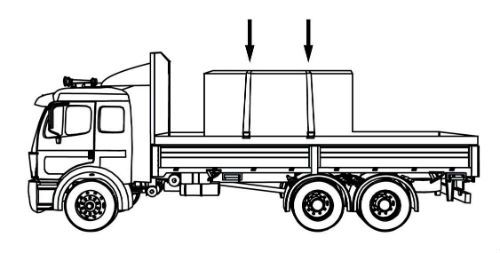CDL Practice Tests: Flatbed Cargo Securement
Choose A Section:
Go!What is the minimum amount of rearward force that a cargo securement system must withstand?
- 80% of cargo weight
- 100% of cargo weight
- 50% of cargo weight
- 20% of cargo weight
Each cargo securement system must be able to withstand a minimum amount of force in each direction.
- Forward Force = 80% of cargo weight when braking while driving straight ahead.
- Rearward Force = 50% of cargo weight when accelerating, shifting gears while climbing a hill, or braking in reverse.
- Sideways Force = 50% of cargo weight when turning, changing lanes, or braking while turning.
-
Upward Force = 20% of cargo weight when traveling over bumps in the road or cresting a hill.
- This requirement is satisfied when the cargo is "Fully Contained."
When securing paper rolls with eyes vertical in a sided vehicle all of the following are acceptable except:
- Placing the rolls against other cargo.
- Placing rolls against the front and walls of the vehicle.
- Placing rolls against the doors.
- Placing the rolls against each other.
- Place paper rolls together in a group so that the structure of the group can be maintained.
- Place paper rolls against:
- The front and walls of the vehicle
- Each other
- Other cargo
What is the minimum requirement for securing roll-off and hook containers?
- Two tiedowns installed lengthwise, each securing one side of the container to one of the vehicle's side rails.
- One tiedown attached to both the vehicle chassis and the container chassis.
- Two hooks, or an equivalent mechanism, securing both sides of the container to the vehicle chassis.
- All of these are acceptable.
Secure to the rear of the vehicle with at least one of the following three mechanisms:
-
Rear Mechanism 1:
One tiedown attached to both the vehicle chassis and the container chassis.
-
Rear Mechanism 2:
Two tiedowns installed lengthwise, each securing one side of the container to one of the vehicle's side rails.
-
Rear Mechanism 3:
Two hooks, or an equivalent mechanism, securing both sides of the container to the vehicle chassis at least as effectively as the tiedowns in the two previous items.
A chock is defined as:
- A structure, device, or another substantial article placed against or around an article to prevent horizontal movement of the article.
- A crosswise load bearing structural component, particularly a part of a log bunk.
- A tapered or wedge-shaped piece used to secure round articles against rolling.
- A short piece of material, usually wood, nailed to the deck to reinforce blocking.
Chock:
A tapered or wedge-shaped piece used to secure round articles against rolling.
When securing concrete pipe with a diameter of more than 45 inches loaded crosswise, how many tiedowns are required through each pipe at minimum?
- 3
- 2
- 1
- It depends on the weight of the pipe.
Requirements for securing the pipe
Secure each pipe with tiedowns through the pipe.
Run at least one tiedown through each pipe in the front half of the load. This includes the middle one if there are an odd number. The tiedown must run rearward at an angle not more than 45° with the horizontal when viewed from the side of the vehicle, whenever practicable.
Run at least one tiedown through each pipe in the rear half of the load. The tiedown must run forward at an angle not more than 45° with the horizontal when viewed from the side of the vehicle, whenever practicable. This holds each pipe firmly in contact with adjacent pipe.
What is bell pipe concrete?
- Concrete used to make bell pipe.
- Pipe whose flanged end is of larger diameter than its barrel.
- Pipe used to make concrete bells.
- Pipe whose flanged end is of smaller diameter than its barrel.
Bell Pipe Concrete:
Pipe whose flanged end is of larger diameter than its barrel.
In cargo securement, a wedge is defined as:
- A tapered piece of material, thick at one end and thin at the other, used to help keep cargo from moving.
- The depression formed between two cylindrical articles when they are laid with their eyes horizontal and parallel against each other.
- A rail along the side of a vehicle that protects the side of the vehicle from impacts.
- A short piece of material, usually wood, nailed to the deck to reinforce blocking.
Wedge:
A tapered piece of material, thick at one end and thin at the other, used to help keep cargo from moving.
Aggregate Working Load Limit is defined as:
- The summation of the working load limits or restraining capacity of all devices used to secure an article on a vehicle.
- The maximum load that may be applied to a component of a cargo securement system during normal service, usually assigned by the manufacturer of the component.
- A combination of securing devices which form an assembly that attaches cargo to, or restrains cargo on, a vehicle or trailer, and is attached to anchor point(s).
- The maximum weight of a load of rocks that a securement device can withstand.
Aggregate Working Load Limit:
The summation of the working load limits or restraining capacity of all devices used to secure an article on a vehicle.
In case of low friction between the cargo and deck, which of these is not a solution?
- Put something heavy on top of the cargo.
- Attach tiedowns to the cargo.
- Use some kind of blocking.
- Set the cargo on friction mats.
What should you use in low-friction situations?
When there is low friction between the cargo and the deck (for example, with snow, ice, sand, gravel, and oil):
- Use tiedowns attached to the cargo.
- Use a means to improve the friction such as friction mats or tiedown that pass over the cargo.
- Use blocking and tiedowns.
The North American Cargo Securement Standard cover vehicles weighing:
- Over 10,000 lbs
- Less than 10,000 lbs
- Over 4,500 lbs
- 26,001 lbs
North American Cargo Securement Standard
What does the Standard cover? (Section 1.1)
- Commercial vehicles (including a combination of vehicles) that are operated on a highway and have a gross vehicle rating over 4,500 kg (10,000 lb.)
Vehicles
About The Flatbed Cargo Securement CDL Manual
Studying the flatbed cargo securement CDL manual is not a requirement for getting your CDL permit or license. It is required knowledge for flatbed drivers.
Some questions you should be able to answer for flatbed cargo securement:
- What is the minimum Working Load Limit of a tiedown used to secure logs?
- What is the minimum weight of a shipment of paper rolls that would require specific securement requirements?
- When securing concrete pipe over 45 inches loaded crosswise, which direction must the tiedowns on the front half of the load run?
- What is a cab shield?
- When securing concrete pipe over 45 inches loaded crosswise, which direction must the tiedowns on the rear half of the load run?
- What is a dunnage bag?
- Who is responsible for inspecting securing devices and cargo within the first 50 miles?
- How many tiedowns are required on a stack of shortwood loaded crosswise?
- What is the minimum working load limit of each tiedown used to secure crushed or flattened vehicles?
- Define 'bolster'
- What is a hook-lift container?
- When a tiedown is attached directly to the cargo, what is the ideal angle where it attached to the vehicle?
What is a securing device?
Any device specifically manufactured to attach or secure cargo to a vehicle or trailer:
- Synthetic Webbing
- Chain
- Wire rope
- Manila rope
- Synthetic rope
- Steel strapping
- Clamps and latches
- Blocking
- Front-end structure
- Grab hooks
- Binders
- Shackles
- Winches
- Stake pockets
- D-rings
- Webbing ratchet
- Bracing
- Friction mat
What is a tiedown?
A combination of securing devices that forms an assembly that:
- Attaches cargo to, or restrains cargo on a vehicle.
- Is attached to anchor point(s).

Some tiedowns are attached to the cargo and provide direct resistance to restrain the cargo from movement.

Some tie-downs pass over or through the cargo. They create a downward force that increases the effect of friction between the cargo and the deck. This friction restrains the cargo.
 Related Cargo Securement Terms That Every Driver Should Know:
Related Cargo Securement Terms That Every Driver Should Know:
-
Tiedown:
A combination of securing devices which form an assembly that attaches cargo to, or restrains cargo on, a vehicle or trailer, and is attached to anchor point(s).
-
Contained:
Cargo is contained if it fills a sided vehicle, and every article is in contact with or sufficiently close to a wall or other articles so that it cannot shift or tip if those other articles are also unable to shift or tip.
-
Blocking:
A structure, device, or another substantial article placed against or around an article to prevent horizontal movement of the article.
How should tiedowns be attached?
Tiedowns can be used in two ways:
-
Attached to the cargo:
- Tiedowns attached to the vehicle and attached to the cargo.
- Tiedowns attached to the vehicle, pass through or aroundan article of cargo, and then are attached to the vehicle again.
-
Pass over the cargo:
- Tiedowns attached to the vehicle, passed over the cargo, and then attached to the vehicle again.
Tiedown placement:

Place the tiedown as close as possible to the spacer.
Position the tiedowns as symetrically as possible over the length of the article.

Position the tiedowns to preserve the integrity of the article.







 TT On Facebook
TT On Facebook